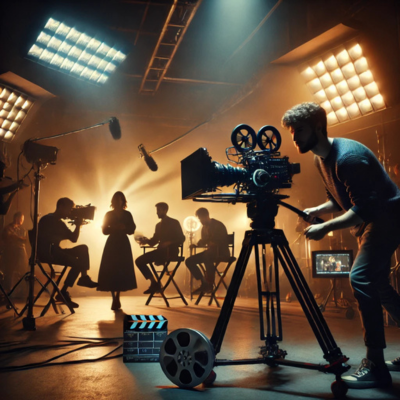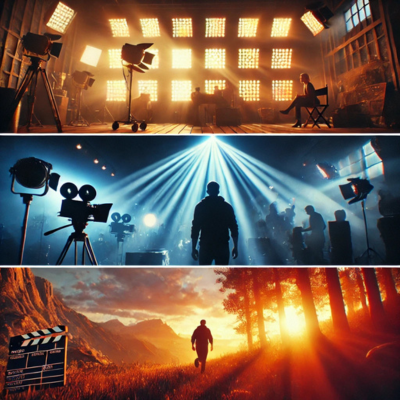The Art of Cinematography: How Lighting and Angles Transform a Scene
The Art of Cinematography: How Lighting and Angles Transform a Scene is a firm base for visual storytelling at its best. Any good film or video is held together by light and camera positions that create mood, space, and emotion. Whether in the thrilling chiaroscuro of shadows or the noble glint of sunlight on a love-warm scene, lighting creates the mood while angles create the perspective. It is the mastery of these elements that will take an ordinary shot into the realm of the cinematic. Join me in discussing the ways that lighting and angles can really take your video production to the next level.

The Art of Cinematography: Understanding the Power of Lighting
Lighting is very important for cinema because it basically defines the moods, tones, and emotional depths for any given scene. It captures the attention of the audience, thus creating a narrative for the film while deciding its visual aesthetics in the process. From warm hues of a sunset for romance to dark hues for a fright film, lighting helps create that mood.
Controlled via intensity, direction, and color of light, the cinematographer must acquire specific effects. Soft light is used to create dreamy flattering effects; direct lighting enhances drama and tension. Cinematic lighting techniques entice filmmakers into drawing emotion from a decision, accentuating details, and leading the viewer’s impression of a scene.

1. Lighting Techniques for Cinematography
Different lighting techniques are tailored for various effects on the screen. The most essential and primary technique for creating depth and balance is three-point lighting: key, fill and backlight. High-key lighting makes a brightly-lit, airy effect, which most comedie. Commercials used in low-key lighting, meanwhile uses contrast and deep shadows, which are usually appropriate for thrillers and noir films.
2. Choosing the Right Source of Natural and Artificial Lighting
Realism is brought into the picture with varying qualities of light, from sunlight to imperfect evoking shadows. But is controllable and must be learned. On the other hand, LED panels, tungsten lights. The other artificial ones enable more significant precision and facility concerning shaping the look for a scene. Blend both natural and artificial lights for a final glimpse effect.
How Lighting Transforms a Scene: The Impact of Shadows and Highlights
The art of lighting is most effective and efficient when it creates illusions using shadows and highlights, thereby changing a scene’s mood, depth, and, most importantly, storytelling. Shadows create mystery, suspense, and depth, whereas highlights emphasize major points and dimension. This is delegating emotions into the audience’s perception of a scene through space capacity within a given shot.
1. Shadows in Cinema Hiding Itself from the Story
Shadows can happen to obscure details, build tension, or create the visual symbolism in thrillers and horror films-the added dimension in fear and uncertainty. Shadings with low-key lighting can leave a character awash in high contrast shadow. Establishing that character as potentially mysterious or threatening, with some influence over how people perceive that character.
2. Direct Attention and Depth with Highlights
The highlights direct attention so that some of the most critical areas within a frame can be the close-up of a character. An imported object, or even during an intense moment. Thus, cinematographers came up with nifty rim lighting and spotlights. For the most important elements in a scene to not get washed out by high visual dominance.
Angles in Cinematography: Framing a Scene for Maximum Impact
The cinematography angles are critical for establishing the emotional tone of a scene, perception about a character, and visualization along with visual storytelling. The choice of camera angles changes a lot. How the person who is watching the film perceives the characters or events. For example, shots taken at a higher point relative to the subject often depict feelings of vulnerability or insignificance. On the other hand, shots taken very low, looking up at a subject, could refer to power or dominance. The framing by the angles helps to lead toward the focus of the audience thus strengthening the narrative without dialogue. A well-selected angle indeed wields an influence over the emotional journey of the viewer, either through tension or intimacy or suspense.
Framing of shot largely contributes to composition and the entire mood of the scene.
1. High and Low Angles
Using high and low angles powerfully illustrates dynamics of power and states of emotions. As a subject, one often appears to be less, weak, or vulnerable under the weight of an angle above him. Most often this placement brings a person into those distress scenes as if that person has been dominated or disempowered. On the other hand, low angles give an impression of authority or superiority. Positioning the camera in such a way so the position is below the subject makes that person appear larger, more impressive, and sometimes taken by authority or strength. These angles forge illusions of awe or intimidation almost before larger-than-life characters and colossal settings.
2. Framing and Composition
Carefully framing a shot ensures emphasis on key story elements while achieving some visual balance. Framing the picture in nine equal parts-dividing frame into thirds-also makes main subjects sit along these lines or intersections. This encourages the viewer to spend more time looking at valuable parts of the frame while still allowing outside to the frame elements to route into this story without ruining it. Further, close-ups here would attract attention to the character’s emotional expression in creating intimacy, while wide shots give a broader context that can boost feelings of isolation or grandeur.
The Art of Cinematography: Mastering Camera Movements and Perspectives
Camera movements and angles in cinematography are essential instruments. This give filmmakers the ability to manipulate viewers’ understanding of a scene and evoke emotional responses. Camera movements such as pans and tilts create a rhythm in a narrative, enhancing either its pace or mood. The Slow and smooth tracking shots can evoke intimacy or build anticipation; conversely, rushed camera motions can inject exhilaration or urgency into a scene. The camera perspective, including its angle and placement, produces another layer of meaning and influences the viewer’s perception of characters and surroundings. Once these skills are well mastered, cinematographers are likely to transform a mundane shot into a vibrant visual narrative, one that speaks uniquely in the language of cinema.
Camera movements and angles also tie into the spatiality of a scene, affecting the understanding of relationships between the environment and characters. An expansive crane shot may emphasize the largeness of the location.
1. Cameraworks and Emotional Effect
Movements of the camera serve a critical dimension to the emotional impact of a scene. For example, a steady tracking shot emulates the character’s journey and can make audiences participant on the action or make them feel like part-and-parcel of a character’s experience. Sudden and erratic moves, for instance, whip pans or shaky handheld shots, methodically show the internal states of characters or provide high conflict for that particular scene. Smooth and flowing movements create scenes of calmness and fluidity, whereas abrupt movements bring an element of surprise or disorientation. The manipulation of time and fluidity in the camera causes filmmakers to access how the audience feels and reacts with the film shown on the screen.
2. Perspectives and Scene Contextualization
The optics in cinematography help present the context of and focus on the scene. For instance, a close-up shot would portray the character’s facial expressions propagated into an agitation of his heart, which at the same time captures an instant of vulnerability. As the other hand, a wide shot would divide the character into a more vast scenario and, as a consequence, expose isolation or the close relationship with the environment. By just altering that perspective with the intimacy levels, the camera could influence the audience’s emotional identification with itself in relation to the characters or the scene itself. The camera positioning: bird’s eye view-low angle-over-the-shoulder would then suddenly tilt power within the scene, as it would significantly influence how characters are perceived and how their actions are interpreted.
Aspect
- Lighting and Camera Angles
- Emotional Tone
How Lighting and Angles Work Together to Shape Emotion in Film
Lighting and angles work in tandem to either heighten or downplay emotions in a scene. For example, low lighting with high angles can make a character appear more vulnerable, while high-key lighting with low angles may make them seem powerful.
The interplay of light and angle can amplify the emotional tone. Example, dark lighting with low angles can create feelings of dread or fear.While bright lighting with a high angle can invoke feelings of safety and security.
Cinematic Lighting Techniques: Creating Mood and Atmosphere
Various lighting techniques create mood by manipulating light intensity, direction, and shadow. Soft light can create warmth, while harsh lighting intensifies drama. Lighting angles directly affect the emotional perception of a scene
Techniques like chiaroscuro (strong contrasts of light and dark) evoke tension or mystery, while soft, diffused lighting evokes calmness, romance, or nostalgia.
Conclusion
To summarize, the camera angle, the geometry of the frame, and the direction of light are probably the most important directing tools for establishing the emotional tone, point of view of the character, and atmosphere of the scene. Angles in film, as up or down angles, set the stage for power or emotional interplay, while framing makes sure the main character stands out for the audience.
Lighting, however, works to create atmosphere by way of intensity and shadow that are emotional influencers. Soft or hard lighting can create warmth, tension, or drama; could strongly emphasize or contrast emotions through light and angle. When these techniques are skillfully combined, they summon a visual language that enhances the story and immerses the audience into the plot.

